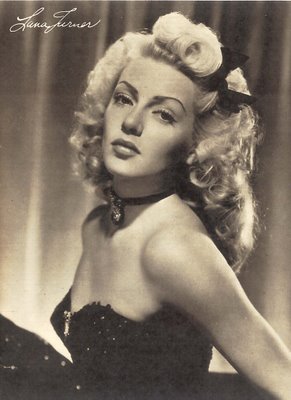

Lana-Thon Today
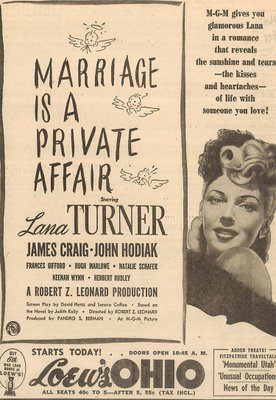
Lana-Thon headquarters is over at Flickhead (HERE), and Ray has links to participating webpages, so by all means check that out. In the meantime --- what’s to say about Lana Turner? Unless you’re a fan, and their numbers aren’t likely to be on the increase, she may come across as a less energized Marilyn Monroe --- or a latter-day de-clawed would-be Harlow sex kitten reigned in by the Code. Then why write about her? I can’t offer a definitive answer because I was born too late. Most of us were. The ones who could tell us all about Lana Turner and what she meant to her once wildly enthusiastic fan base are a dwindling lot of world war veterans --- the men who served and worshipped Lana, and the women who crowded her movies stateside and lived vicariously through her romances, both onscreen and off. It’s easy for our generation to regard her as a studio manufactured joke, for we never experienced the anxieties that a star like Lana was there to alleviate. She was comfort food with a brief shelf life, but like strawberries fresh from the market, she had an intoxicating flavor that just can’t be experienced so many years after the initial purchase, and a movie like Marriage Is A Private Affair can give but the barest hint of what it must have been like to taste Lana in her prime. She would certainly make better pictures (The Postman Always Rings Twice, The Bad and The Beautiful, Imitation Of Life), but none that summon up her essential appeal like this one. That it’s so utterly forgotten today is no doubt due to the fact that Marriage Is A Private Affair exists purely as a Lana Turner vehicle, 116 minutes to luxuriate in her presence --- not enough for us, but plenty for moviegoers in 1944.
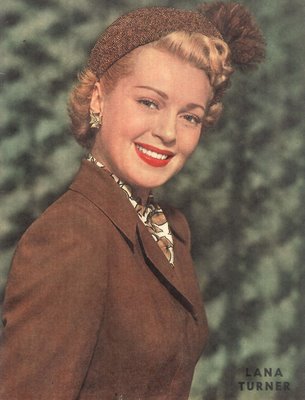
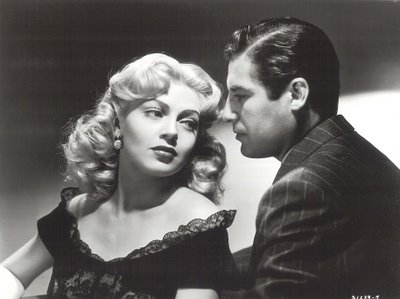
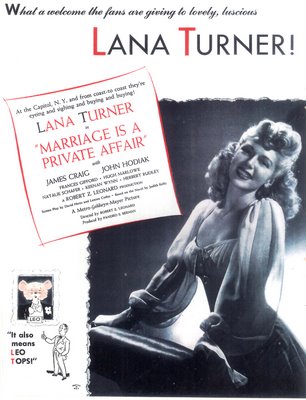
In case you haven’t seen it on TCM, here’s the set-up. Lana’s a party girl with money who marries serviceman John Hodiak. Complications ensue. That’s pretty much it. The movie opens with an outsized wedding sequence that must have set many a second-shift Lockheed girl’s heart a-flutter, and the extended honeymoon idyll, which seems destined to run into 1945, provides the sort of vicarious you-are-there sensation that all movies strive for, and seldom attain. This is where we really have to admire the efficiency of the Dream Factory. That wedding night, staged as it was on the most patently artificial stage since Random Harvest, fulfilled the wartime yearnings of both sexes. Men in uniform could substitute themselves for John Hodiak (no problem there, since Hodiak was anything but an imposing presence, and even the lowliest G.I. could imagine supplanting him), while women could anticipate a future that might include a romantic wedding trip where money is seemingly no object and no one has to worry about getting back to work. Reality never intrudes upon Lana’s world. That all seems dated and foolish to us now, but it was more than satisfying then. Marriage Is A Private Affair premiered with 98 prints on military camps and bases in September 1944. Lana Turner appeared with the show in Naples, Italy, and provided a filmed prologue in which she greeted soldier audiences from the screen and delivered a "chin-up" message. This was her first picture in eleven months (maternity leave) and the anticipation was intense. Marriage Is A Private Affair went on to deliver $1.9 million in domestic rentals against a negative cost of $1.5, with $715,000 in foreign rentals. The final profit was $237,000.



I’m told that Marriage Is A Private Affair was Tennessee William’s first Hollywood writing assignment. He contributed some dialogue. Actually, the writing isn’t so bad. A best selling novel was credited as the source, but the Breen Office had forced a near-total abandonment of that, being as how it dealt rather explicitly with adultery and featured an abortion among the key plot devices. Books like these were as disposable then as they are forgotten now, and yet I did find multiple copies of the novel for sale at AbeBooks on line, so a lot of them must be turning up in attics and estate auctions (it was also serialized in Ladies Home Journal). Is there anything so discredited today as a movie adaptation of a best-selling novel that no one remembers? One noteworthy thing about Marriage Is A Private Affair is the supporting cast. This was the first time Lana Turner had carried a picture on her own --- before, there had been at least one co-star of equal stature --- but this time, she’s backed up by an interesting group of young contract hopefuls, and that in itself makes this picture well worth seeing. James Craig is Hodiak’s rival for her affections. He’s mustachioed and smirked out as if doubling for now-in-the-service Clark Gable. It’s one of the most slavishly imitative performances you’re ever likely to see. Tom Drake has one big scene where he plays the ghost of a downed flyer who’d been Lana’s sweetheart. This may have been the audition, and it’s a nice one, that got Drake the Meet Me In St. Louis part. Frances Gifford never seems to have gotten the breaks, at MGM or elsewhere, but she’s awfully good here in what’s easily the most interesting part in the picture. Herbert Rudley never scaled the heights either, but I always liked him (there’s a nice chat with Rudley in one of Tom Weaver’s terrific interview books).
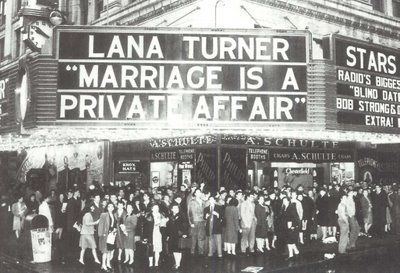
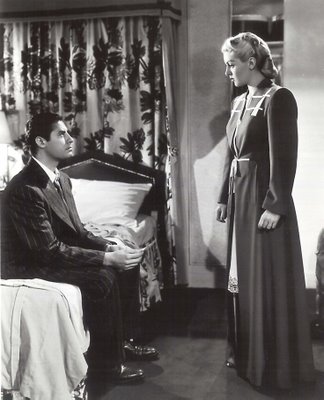
Check out Lana Turner’s Sensational Loves. This article was published in tandem with the release of Marriage Is A Private Affair. Here was another instance of a star’s personal life serving the interests of the product. Even the title promises an insider’s peek at Lana’s marital wreckage. The "Welcome Back" trade ad refers to that absence of almost a year, and the fan frenzy that greeted her return (the crowd in front of the theatre was typical during that era when movies really had a mass audience). Note the twin bed in this shot with John Hodiak --- that was the one sticking point with audiences during those military base premieres, for even during the honeymoon, Lana and Hodiak occupied separate beds. The whistles and catcalls in response to these Code-dictated accommodations were said to have been deafening. Marriage Is A Private Affair was truly an instance of a movie that could only work, and did work, at a particular moment in time. There were many such pictures coming out of the studios then, particularly during the war (and it seems the lion’s share were from Metro). They may not survive as popular entertainment for a general audience, but for fans like us, they’re fascinating time capsules, and this is one Lana Turner obscurity that’s well worth catching next time it’s on TCM.
